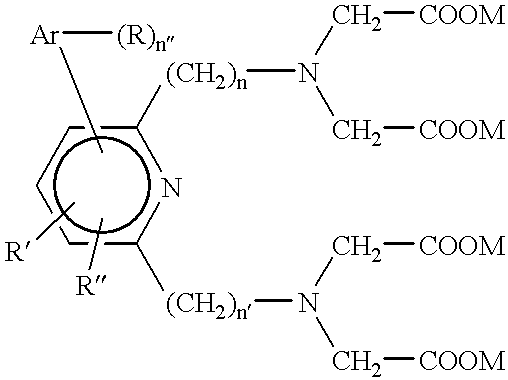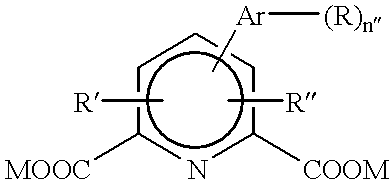Homogeneous fluorassay methods employing fluorescent background rejection and water-soluble rare earth metal chelates
- Summary
- Abstract
- Description
- Claims
- Application Information
AI Technical Summary
Benefits of technology
Problems solved by technology
Method used
Image
Examples
example 1
Preparation of Aryl-Substituted Pyridine Ligands
The process of this Example, which is based upon the teachings of USSN 712,774 of Hale and Solas, is used to prepare a family of aryl-substituted pyridyl tetraacid ligands. These ligands have the general structure ##STR14##
wherein n and n' are independently the integers 1 or 2, Ar is an aryl, n" is an integer equal to the number of available bonding sites on Ar, and the n" Rs, R' and R" are each independently selected as set forth hereinabove and especially from among hydrogens, alkoxies, amines and isothiocyanates. In a representative preparation the following reactions are carried out:
A. 1,5-di(2-furyl)-3-phenyl-1,5-pentanedione
are reacted at 60.degree. C. Following reaction, product crystals are recovered. Yield of pentanedione, 103.5 gms or 57.3%.
B. 4-Phenyl-2,6-di(2-furyl)pyridine
The "dione", as produced in step A. the hydroxylamine and the butanol are combined, refluxed and stirred, cooled and stirred for about 60 hours. The resu...
example 2
Preparation of Diamine Triacids
These materials are prepared using the process set forth in U.S. Pat. No. 4,352,751.
example 3
Preparation of Phenanthroline Tetraacetic Acid Ligands
These materials are prepared using the process set forth in European Patent Application 0068875 (Eastman Kodak).
PUM
| Property | Measurement | Unit |
|---|---|---|
| Time | aaaaa | aaaaa |
| Volume | aaaaa | aaaaa |
| Volume | aaaaa | aaaaa |
Abstract
Description
Claims
Application Information
 Login to View More
Login to View More - R&D
- Intellectual Property
- Life Sciences
- Materials
- Tech Scout
- Unparalleled Data Quality
- Higher Quality Content
- 60% Fewer Hallucinations
Browse by: Latest US Patents, China's latest patents, Technical Efficacy Thesaurus, Application Domain, Technology Topic, Popular Technical Reports.
© 2025 PatSnap. All rights reserved.Legal|Privacy policy|Modern Slavery Act Transparency Statement|Sitemap|About US| Contact US: help@patsnap.com



